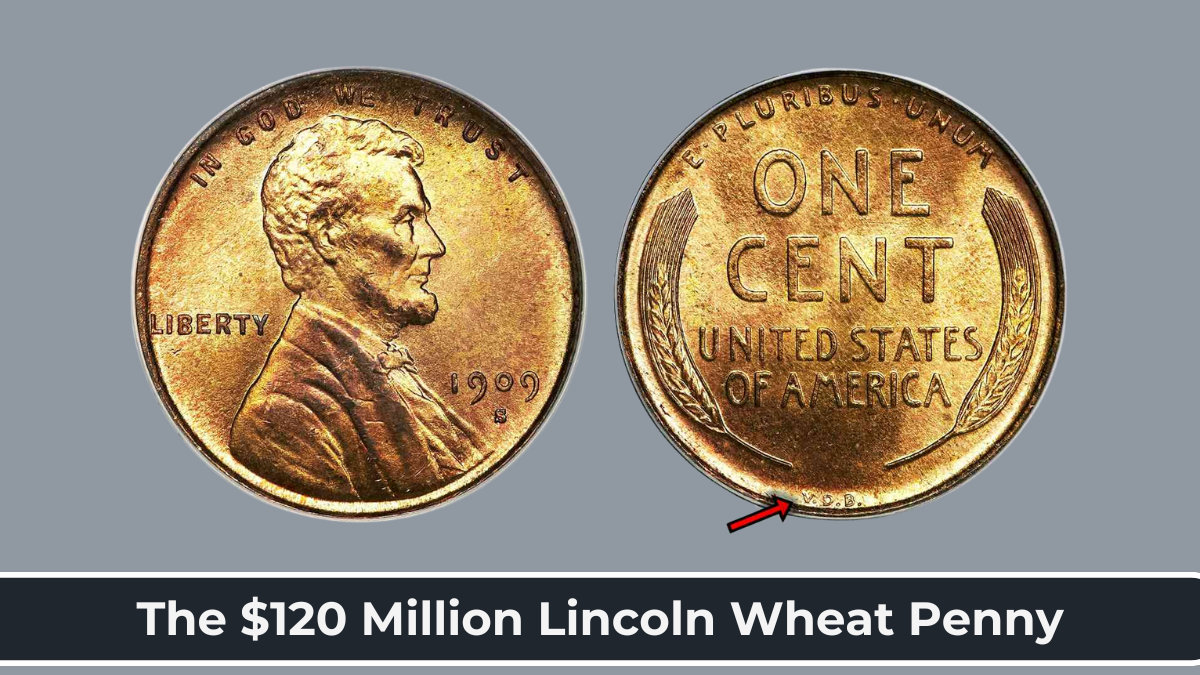In the world of rare coin collecting, one penny stands above all others—the 1943-D Copper Lincoln Wheat Penny, reportedly valued at an astonishing $120 million. This remarkable coin, a product of a wartime minting error, is a perfect blend of historical significance, extreme rarity, and pristine condition. Collectors and historians alike are fascinated by its story, proving that even a humble one-cent piece can become one of the most valuable treasures in numismatic history.
The Birth of the Lincoln Wheat Penny
The Lincoln Wheat Penny debuted in 1909 to celebrate the 100th anniversary of Abraham Lincoln’s birth. Designed by Victor David Brenner, it became the first U.S. coin to feature a real historical figure rather than the traditional Lady Liberty.
- Obverse (Front): Lincoln’s portrait, based on an 1864 photograph by Mathew Brady.
- Reverse (Back): Two wheat stalks surrounding the words “ONE CENT” and “UNITED STATES OF AMERICA”, symbolizing America’s agricultural prosperity.
This design remained in circulation until 1958, when it was replaced by the Lincoln Memorial Penny.
The 1943 Copper Penny: A Wartime Error
During World War II, copper was a critical war material used for manufacturing ammunition and military equipment. To conserve resources, the U.S. Mint switched from copper to zinc-coated steel for pennies in 1943. These steel pennies had a distinct silvery appearance and were the only official pennies produced that year.
However, due to a minting mistake, a few leftover copper blanks (planchets) from 1942 were accidentally struck with the 1943 date. This resulted in the creation of one of the rarest and most valuable pennies in history—the 1943 Copper Penny.
The $120 Million 1943-D Copper Penny
Most of the known 1943 Copper Pennies were struck at the Philadelphia and San Francisco mints, but the Denver Mint (“D” mintmark) produced only one known example, making it the rarest of them all.
Why Is It Worth $120 Million?
Several factors contribute to its unprecedented value:
Extreme Rarity – Only one confirmed 1943-D Copper Penny exists, making it a one-of-a-kind numismatic treasure.
Historical Significance – It was accidentally produced during a critical wartime period.
Pristine Condition – The coin has been preserved in near-perfect condition, increasing its desirability.
Collector Demand – High-profile collectors and investors have driven its valuation to astronomical levels.
How to Identify a 1943 Copper Penny
Because of its value, counterfeit 1943 Copper Pennies are common. Many forgeries involve copper-plating real 1943 steel pennies or altering the dates of 1945, 1948, or 1949 pennies.
Magnet Test – A real 1943 Copper Penny WILL NOT stick to a magnet, while a fake (steel) version will.
Weight Test – A genuine copper penny weighs 3.11 grams, whereas a steel penny weighs 2.7 grams.
Mint Mark Verification – The rarest version has a “D” mintmark below the date, indicating it was minted in Denver.
Authentication – Get the coin professionally graded by PCGS (Professional Coin Grading Service) or NGC (Numismatic Guaranty Company).
Other Valuable Lincoln Wheat Pennies
While the 1943-D Copper Penny is the most valuable, several other rare Lincoln Wheat Pennies are worth thousands—even millions—of dollars.
| Coin | Estimated Value | Notable Feature |
|---|---|---|
| 1909-S VDB | Up to $100,000 | First Lincoln cent with designer’s initials. |
| 1914-D | Up to $150,000 | Rare Denver Mint production. |
| 1922 “No D” | Up to $90,000 | Denver Mint error—missing mint mark. |
| 1943 Copper Penny (P & S Mints) | Up to $1.7 million | Accidentally struck in copper instead of steel. |
| 1955 Doubled Die | Up to $125,000 | Double-struck design causes a dramatic visual effect. |
Could a $120 Million Penny Still Be in Circulation?
While most valuable Lincoln Wheat Pennies have been discovered, some rare specimens could still be hiding in:
Old coin collections
Bank rolls of pennies
Estate sales and flea markets
Inherited coin collections
Though the chances of finding a $120 million penny are slim, there are still valuable Wheat Pennies worth hundreds or thousands of dollars waiting to be found.
How to Preserve and Sell a Valuable Penny
If you believe you’ve found a rare Lincoln Wheat Penny, follow these steps:
- DO NOT clean the coin! Cleaning damages the surface and lowers its value.
- Store it in a protective holder – Use a coin slab or airtight case to prevent damage.
- Get professional authentication – Services like PCGS or NGC can verify authenticity and grade the coin.
- Sell through reputable dealers – Use auction houses, coin dealers, or numismatic marketplaces like Heritage Auctions and GreatCollections.
The Impact on Coin Collecting
The discovery of a $120 million penny has ignited worldwide interest in coin collecting. Enthusiasts and investors alike are drawn to the possibility that a simple penny could be a hidden fortune.
This story serves as a reminder that rare treasures can be hiding in plain sight, inspiring a new generation of collectors to carefully examine their coins.
So, before you dismiss your spare change, take a moment to check—you might be holding the most valuable penny in history!
FAQs
Only about 20-40 genuine 1943 Copper Pennies are known, but only one confirmed Denver (D) Mint version exists.
A real 1943 Copper Penny will NOT stick to a magnet and weighs 3.11 grams.
Sell through auction houses, reputable coin dealers, or numismatic marketplaces like Heritage Auctions.
The 1943-D Copper Penny is valued at $120 million, making it the most expensive penny ever recorded.
Rare Wheat Pennies do occasionally appear in coin rolls, old collections, and estate sales.

